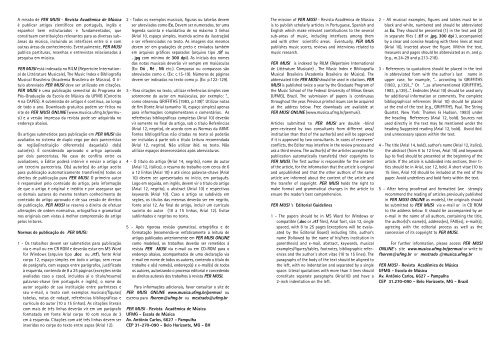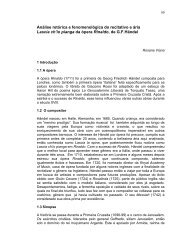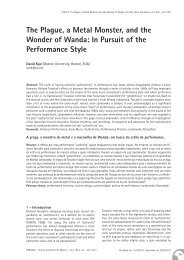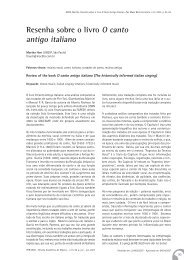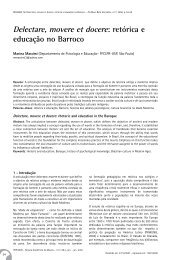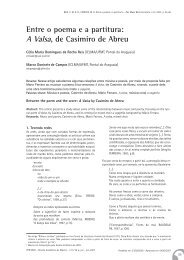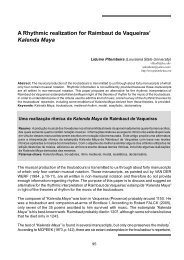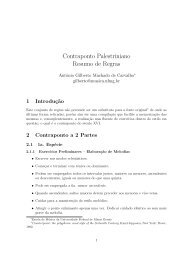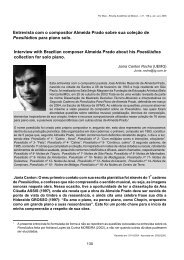capa v17.indd - Escola de Música da UFMG
capa v17.indd - Escola de Música da UFMG
capa v17.indd - Escola de Música da UFMG
Create successful ePaper yourself
Turn your PDF publications into a flip-book with our unique Google optimized e-Paper software.
A missão <strong>de</strong> PER MUSI - Revista Acadêmica <strong>de</strong> <strong>Música</strong><br />
é publicar artigos científicos em português, inglês e<br />
espanhol bem estruturados e fun<strong>da</strong>mentados, que<br />
constituam contribuições relevantes para as diversas subáreas<br />
<strong>da</strong> música, incluindo as interfaces entre si e com<br />
outras áreas do conhecimento. Eventualmente, PER MUSI<br />
publica partituras, resenhas e entrevistas relaciona<strong>da</strong>s à<br />
pesquisa em música.<br />
PER MUSI está in<strong>de</strong>xa<strong>da</strong> no RILM (Répertoire International<br />
<strong>de</strong> Littérature Musicale), The Music In<strong>de</strong>x e Bibliografia<br />
Musical Brasileira (Aca<strong>de</strong>mia Brasileira <strong>de</strong> <strong>Música</strong>). O título<br />
abreviado PER MUSI <strong>de</strong>ve ser utilizado em citações.<br />
PER MUSI é uma publicação semestral do Programa <strong>de</strong><br />
Pós-Graduação <strong>da</strong> <strong>Escola</strong> <strong>de</strong> <strong>Música</strong> <strong>da</strong> <strong>UFMG</strong> (Conceito<br />
4 na CAPES). A submissão <strong>de</strong> artigos é contínua, ao longo<br />
<strong>de</strong> todo o ano. Downloads gratuitos po<strong>de</strong>m ser feitos no<br />
site <strong>de</strong> PER MUSI ONLINE (www.musica.ufmg.br/permusi)<br />
e a versão impressa <strong>da</strong> revista po<strong>de</strong> ser adquiri<strong>da</strong> no<br />
en<strong>de</strong>reço abaixo.<br />
Os artigos submetidos para publicação em PER MUSI são<br />
avaliados no sistema <strong>de</strong> duplo cego por dois pareceristas<br />
<strong>de</strong> região/instituição diferente(s) <strong>da</strong>quela(s) do(s)<br />
autor(es). É consi<strong>de</strong>rado aprovado o artigo aprovado<br />
por dois pareceristas. No caso <strong>de</strong> conflito entre os<br />
avaliadores, o Editor po<strong>de</strong>rá intervir e enviar o artigo a<br />
um terceiro parecerista. O(s) autor(es) do artigo aceito<br />
para publicação automaticamente transfere(m) todos os<br />
direitos <strong>de</strong> publicação para PER MUSI. O primeiro autor<br />
é responsável pelo conteúdo do artigo, pela informação<br />
<strong>de</strong> que o artigo é original e inédito e por assegurar que<br />
os <strong>de</strong>mais autores do mesmo tenham conhecimento do<br />
conteúdo do artigo aprovado e <strong>de</strong> sua cessão <strong>de</strong> direitos<br />
<strong>de</strong> publicação. PER MUSI se reserva o direito <strong>de</strong> efetuar<br />
alterações <strong>de</strong> or<strong>de</strong>m normativa, ortográfica e gramatical<br />
nos originais com vistas à melhor compreensão do artigo<br />
pelos leitores.<br />
Normas <strong>de</strong> publicação <strong>de</strong> PER MUSI:<br />
1 - Os trabalhos <strong>de</strong>vem ser submetidos para publicação<br />
via e-mail ou em CR ROM e <strong>de</strong>verão estar em MS Word<br />
for Windows (arquivo tipo .doc ou .rtf), fonte Arial<br />
corpo 12, espaço simples em todo o artigo, sem recuo<br />
<strong>de</strong> parágrafo, com espaço entre parágrafos, justificado<br />
à esquer<strong>da</strong>, contendo <strong>de</strong> 8 a 25 páginas (exceções serão<br />
avalia<strong>da</strong>s caso a caso), incluídos aí o título/resumo/<br />
palavras-chave (em português e inglês), o nome do<br />
autor seguido <strong>de</strong> sua instituição entre parênteses e<br />
seu e-mail, o texto com exemplos musicais/figuras/<br />
tabelas, notas <strong>de</strong> ro<strong>da</strong>pé, referências bibliográficas e<br />
currículo do autor (10 a 15 linhas). As citações literais<br />
com mais <strong>de</strong> três linhas <strong>de</strong>verão vir em um parágrafo<br />
formatado em fonte Arial corpo 10 com recuo <strong>de</strong> 3<br />
cm à esquer<strong>da</strong>. Citações com até três linhas <strong>de</strong>vem ser<br />
inseri<strong>da</strong>s no corpo do texto entre aspas (Arial 12).<br />
2 - Todos os exemplos musicais, figuras ou tabelas <strong>de</strong>vem<br />
ser abreviados como Ex. Devem ser numerados, ter uma<br />
legen<strong>da</strong> sucinta e eluci<strong>da</strong>tiva <strong>de</strong> no máximo 3 linhas<br />
(Arial 10, espaço simples, inseri<strong>da</strong> acima <strong>da</strong> ilustração)<br />
e ser referenciados no texto. As imagens dos mesmos<br />
<strong>de</strong>vem ser em gra<strong>da</strong>ções <strong>de</strong> preto e enviados também<br />
em arquivos gráficos separados (arquivo tipo .tif ou<br />
. jpg com mínimo <strong>de</strong> 300 dpi). As iniciais dos nomes<br />
<strong>da</strong>s notas musicais <strong>de</strong>verão vir sempre em maiúsculas<br />
(Ex: Dó , Ré , Mi etc.). Compasso ou compassos são<br />
abreviados como c. (Ex: c.15-19). Números <strong>de</strong> páginas<br />
<strong>de</strong>vem ser indica<strong>da</strong>s no texto como p. (Ex: p.122-129).<br />
3 - Para citações no texto, utilizar referências simples com<br />
sobrenome do autor em maiúsculas, por exemplo: “...<br />
como observou GRIFFITHS (1983, p.139)”. Utilizar notas<br />
<strong>de</strong> fim (fonte Arial tamanho 10, espaço simples) apenas<br />
para informações complementares e comentários. As<br />
referências bibliográficas completas (Arial 10) <strong>de</strong>verão<br />
vir somente no final do artigo, sob o título Referências<br />
(Arial 12, negrito), <strong>de</strong> acordo com as Normas <strong>da</strong> ABNT.<br />
Fontes bibliográficas não cita<strong>da</strong>s no texto só po<strong>de</strong>rão<br />
ser incluí<strong>da</strong>s à parte sob o título Leitura recomen<strong>da</strong><strong>da</strong><br />
(Arial 12, negrito). Não utilizar ibid. no texto. Não<br />
utilizar espaços <strong>de</strong>snecessários após abreviaturas.<br />
4 - O título do artigo (Arial 14, negrito), nome do autor<br />
(Arial 12, itálico), o resumo do trabalho com cerca <strong>de</strong> 6<br />
a 12 linhas (Arial 10) e até cinco palavras-chave (Arial<br />
10) <strong>de</strong>vem ser apresentados no início, em português.<br />
Logo em segui<strong>da</strong>, em inglês, <strong>de</strong>vem vir o título do artigo<br />
(Arial 12, negrito), o abstract (Arial 10) e respectivas<br />
keywords (Arial 10). Caso o artigo se subdivi<strong>da</strong> em<br />
seções, os títulos <strong>da</strong>s mesmas <strong>de</strong>verão ser em negrito,<br />
fonte arial 12. Ao final do artigo, incluir um currículo<br />
sucinto do autor (10 a 15 linhas, Arial 12). Evitar<br />
sublinhados e negritos no texto.<br />
5 - Após rigorosa revisão gramatical, ortográfica e <strong>de</strong><br />
formatação (recomen<strong>da</strong>-se enfaticamente a leitura <strong>de</strong><br />
artigos publicados anteriormente em PER MUSI ONLINE<br />
como mo<strong>de</strong>los), os trabalhos <strong>de</strong>verão ser remetidos à<br />
revista PER MUSI via e-mail ou em CD-ROM para o<br />
en<strong>de</strong>reço abaixo, acompanhados <strong>de</strong> uma <strong>de</strong>claração via<br />
e-mail em nome <strong>de</strong> todos os autores, contendo o título do<br />
trabalho e o(s) nome(s), en<strong>de</strong>reço(s) e e-mail(s) <strong>de</strong> todos<br />
os autores, autorizando o processo editorial e conce<strong>de</strong>ndo<br />
os direitos autorais dos trabalhos à revista PER MUSI.<br />
Para informações adicionais, favor consultar o site <strong>de</strong><br />
PER MUSI ONLINE www.musica.ufmg.br/permusi ou<br />
escreva para fborem@ufmg.br ou mestrado@ufmg.br<br />
PER MUSI - Revista Acadêmica <strong>de</strong> <strong>Música</strong><br />
<strong>UFMG</strong> - <strong>Escola</strong> <strong>de</strong> <strong>Música</strong><br />
Av. Antônio Carlos, 6627 - Pampulha<br />
CEP 31-270-090 - Belo Horizonte, MG - BH<br />
The mission of PER MUSI - Revista Acadêmica <strong>de</strong> <strong>Música</strong><br />
is to publish scholarly articles in Portuguese, Spanish and<br />
English which make relevant contributions to the several<br />
sub-areas of music, including interfaces among them<br />
and with other scientific areas. Eventually, PER MUS<br />
publishes music scores, reviews and interviews related to<br />
music research.<br />
PER MUSI is in<strong>de</strong>xed by RILM (Répertoire International<br />
<strong>de</strong> Littérature Musicale) , The Music In<strong>de</strong>x e Bibliografia<br />
Musical Brasileira (Aca<strong>de</strong>mia Brasileira <strong>de</strong> <strong>Música</strong>). The<br />
abbreviated title PER MUSI should be used in citations. PER<br />
MUSI is published twice a year by the Graduate Program of<br />
the Music School of the Fe<strong>de</strong>ral University of Minas Gerais<br />
(<strong>UFMG</strong>), Brazil. The submission of papers is continuous<br />
throughout the year. Previous printed issues can be acquired<br />
at the address below. Free downloads are available at<br />
PER MUSI ONLINE (www.musica.ufmg.br/permusi).<br />
Articles submitted to PER MUSI are double -blind<br />
peer-reviewed by two consultants from different area/<br />
institution than that of the author(s) and will be approved<br />
if it is approved by two consultants. In cases of reviewers’<br />
conflicts, the Editor may interfere in the review process and<br />
ask a third review. The author(s) of the articles accepted for<br />
publication automatically transfer(s) their copyrights to<br />
PER MUSI. The first author is responsible for the content<br />
of the article, for the information that the article is original<br />
and unpublished and that the other authors of the same<br />
article are informed about the content of the article and<br />
the transfer of copyright. PER MUSI holds the right to<br />
make format and grammatical changes in the article to<br />
ensure the rea<strong>de</strong>r’s best comprehension.<br />
PER MUSI ’s Editorial Gui<strong>de</strong>lines<br />
1 - The papers should be in MS Word for Windows or<br />
compatible (.doc or .rtf files), Arial font, size 12, single<br />
spaced, with 8 to 25 pages (exceptions will be evaluated<br />
by the Editorial Board) including title, author’s<br />
name (followed by the name of his/hers institution in<br />
parenthesis) and e-mail, abstract, keywords, musical<br />
examples/figures/tables, footnotes, bibliographic references<br />
and the author´s short vitae (10 to 15 lines). The<br />
paragraphs of the body of the text should be aligned to<br />
the left, with no in<strong>de</strong>ntation and separated by a single<br />
space. Literal quotations with more than 3 lines should<br />
constitute separate paragraphs (Arial10) and have a<br />
2-inch in<strong>de</strong>ntation on the left.<br />
2 - All musical examples, figures and tables must be in<br />
black and white, numbered and should be abbreviated<br />
as Ex. They should be presented (1) in the text and (2)<br />
in separate files ( .tif or .jpg, 300 dpi ), accompanied<br />
by a clear and concise heading with three lines at most<br />
(Arial 10), inserted above the figure. Within the text,<br />
measures and pages should be abbreviated as m. and p.<br />
(e.g., m.24-29 and p.213-218).<br />
3 - References to quotations should be placed in the text<br />
in abbreviated form with the author´s last name in<br />
upper case, for example, “... according to GRIFFITHS<br />
(1983, p.139)...” Or “...as aforementioned (GRIFFITHS,<br />
1983, p.139)...”. Endnotes (Arial 10) should be used only<br />
for additional information or comments. The complete<br />
bibliographical references (Arial 10) should be placed<br />
at the end of the text (e.g., GRIFFITHS, Paul. The String<br />
Quartet. New York: Thames & Hudson, 1983) un<strong>de</strong>r<br />
the heading References (Arial 12, bold). Sources not<br />
used directly in the text may be mentioned un<strong>de</strong>r the<br />
heading Suggested reading (Arial 12, bold). Avoid ibid.<br />
and unnecessary spaces within the text.<br />
4 - The title (Arial 14, bold), author’s name (Arial 12, italics),<br />
the abstract (from 6 to 12 lines, Arial 10) and keywords<br />
(up to five) should be presented at the beginning of the<br />
article. If the article is subdivi<strong>de</strong>d into sections, their titles<br />
should be in Arial, size 12, bold. A short vitae (10 to<br />
15 lines, Arial 10) should be inclu<strong>de</strong>d at the end of the<br />
paper. Avoid un<strong>de</strong>rlines and bold fonts within the text.<br />
5 - After being proofread and formatted (we strongly<br />
recommend the reading of articles previously published<br />
in PER MUSI ONLINE as mo<strong>de</strong>ls), the originals should<br />
be submitted to PER MUSI via e-mail or in CD ROM<br />
to the address below. It should be accompanied by an<br />
e-mail in the name of all authors, containing the title,<br />
the author(s)’s name(s), address(es), FAX(es), e-mail(s),<br />
agreeing with the editorial process as well as the<br />
concession of its copyright to PER MUSI.<br />
For further information, please access PER MUSI<br />
ONLINE´s site www.musica.ufmg.br/permusi or write to<br />
fborem@ufmg.br or mestrado @musica.ufmg.br<br />
PER MUSI - Revista Acadêmica <strong>de</strong> <strong>Música</strong><br />
<strong>UFMG</strong> - <strong>Escola</strong> <strong>de</strong> <strong>Música</strong><br />
Av. Antônio Carlos, 6627 - Pampulha<br />
CEP 31.270-090 - Belo Horizonte, MG - Brazil


